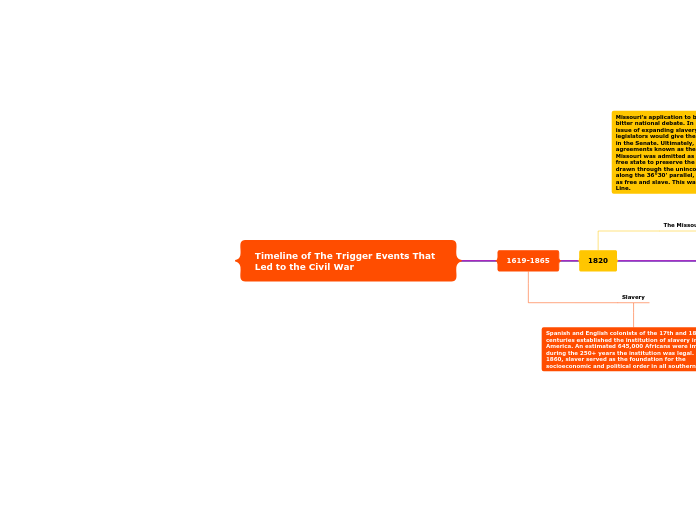Timeline of The Trigger Events That Led to the Civil War
1619-1865
Slavery
Spanish and English colonists of the 17th and 18th centuries established the institution of slavery in North America. An estimated 645,000 Africans were imported during the 250+ years the institution was legal. By 1860, slaver served as the foundation for the socioeconomic and political order in all southern states.
1820
The Missouri Compromise
Missouri's application to be a slave state sparked a bitter national debate. In addition to the deeper moral issue of expanding slavery, adding pro-slavery legislators would give the pro-slavery faction a majority in the Senate. Ultimately, the Senate reached a series of agreements known as the Missouri Compromise. Missouri was admitted as a slave state and Maine as a free state to preserve the balance. a line was also drawn through the unincorporated western territories along the 36°30' parallel, dividing the north and south as free and slave. This was known as the Mason-Dixon Line.
1831
Nat Turner's Rebellion
In August 1831, a slave named Nat Turner incited an uprising that spread through several plantations in Southern Virginia. Turner and approximately 70 cohorts killed around 60 white people. After two days of terror, militia infantry and artillery were deployed to suppress the rebellion. 55 slaves, including Turner, were tried and executed for their role in the insurrection. Nearly 200 more were lynched by frenzied mobs.
1846-1850
The Wilmot Proviso
The Wilmot Proviso was legislation that would have outlawed slavery in territory acquired by the U.S. as a result of the Mexican-American War (most of the Southwest to California). The legislation failed to pass. Nevertheless, the intense debate surrounding the Proviso prompted the first serious discussions of secession.
1850
The Compromise of 1850
The compromise of 1850 admitted California as a free state and did not regulate slavery in the remainder of the Mexican cession. The compromise strengthened the Fugitive Slave Act, a law which compelled Northerners to seize and return escaped slaves to the South. In many ways, The Compromise reinforced the structural disparity that divided the US. The new fugitive slave Act forced non-slave holders by law to participate in the institution which increased polarization among centrist citizens
1852
Uncle Tom's Cabin
Harriet Beecher Stowe's fictional exploration of slave life was a cultural sensation. Northerners felt as if their eyes had been opened to the horrors of slavery, while Southerners protested that Stowe's work was slanderous. The book brought the issue of slavery to life and widened the division between the North and South.
1854-1859
Bleeding Kansas
The Kansas-Nebraska Act of 1854 established Kansas and Nebraska as territories and set the stage for "Bleeding Kansas" through its adoption of popular sovereignty. Under popular sovereignty, the residents of the territories decided by popular referendum if the state is to be free or enslaved. Settlers from the North and the South into Kansas, hoping to swell the numbers on their side of the debate. Passions were inflamed and violence raged. the violence subsided in 1859 but not before more than 50 settlers had been killed.
1857
Dred Scott v. Sanford
Dred Scott was a slave who attempted to sue for his freedom. The case eventually rose to the level of the Supreme Court. The justices found that, as a slave, Dred Scott had none of the legal rights or recognitions of a United States citizen. Classifying slaves and those of African descent inferior made the federal government's authority to regulate the institution of slavery much more ambiguous.
1858
Lincoln-Douglas Debates
Abraham Lincoln and Senator Stephen Douglas had 7 public debates across Illinois where they discussed the most controversial issue of the antebellum era: slavery. Although Douglas won three senate race, these debated propelled Lincoln into the national spotlight and led to his presidential nomination in 1860.
1859
John Brown's Raid
In October 1859, abolitionist John Brown and 19 supporters led a raid on the federal armoury and arsenal at Harper's Ferry, Virginia. Their motive was to capture and confiscate the arms and distribute them among local slaves to begin an armed insurrection. US Marines led by Col. Robert E. Lee put down the uprising. there were casualties on both sides; 7 people were killed and at least 10 injured before Brown and his remaining men were captured. Brown was tried for treason, convicted and hanged in Charles Town On December 2, 1859.
1860
Abraham Lincoln's Election
Abraham Lincoln was elected as President by a considerable margin in 1860, despite not being included on many Southern ballots. As a Republican, his party's anti-slavery outlook struck fear into many southerners. On December 20, 1860, a little over a month after the polls closed, South Carolina seceded from the Union, Six more states followed by spring of 1861.
1861
The Battle of Fort Sumter
With secession, several federal forts, including Fort Sumter in South Carolina, suddenly became outposts in a foreign land. Abraham Lincoln made the decision to send fresh supplies to the beleaguered garrisons. On 12 April 1861, Confederates turned back the supply convoy to Fort Sumter and opened a 34-hour artillery bombardment on the stronghold. The garrisons surrendered on April 13th. The civil War was now underway. On April 15, Lincoln called for 75,000 volunteers to join the Union army. Unwilling to contribute troops. Virginia, Arkansas, North Carolina and Tennesse dissolved the ties ti the federal government.
